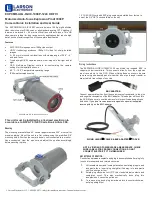
© National Instruments
|
4-7
NI 17xx Smart Camera User Manual
strobe time, the controller can be programmed for any arbitrary strobe duration, and the assertion
edge of the smart camera output can start the strobe timer in the controller.
Caution
If you are using the 5 V strobe output or the 24 V strobe output, the
software does not impose any limits on the duration or the duty cycle of the strobe
output. You must ensure that your requested exposure time and the frame rate result
in duration and duty cycle that do not violate the limits of the external controller
and/or light(s). Refer to the
Maximum Frame Rate
section of Chapter 5,
Image
Acquisition
, for more information.
Enable the 5 V and 24 V lighting outputs as follows:
•
In Vision Builder AI, enable the
5 V TTL Strobe
and/or
24 V Strobe
controls on the
Lighting
tab of the
Acquire Image (Smart Camera)
step. Refer to the
NI Vision Builder
for Automated Inspection: Configuration Help
for more information about configuring the
5 V TTL and 24 V strobe outputs.
•
In LabVIEW, configure the
24V Strobe
and
5V Strobe
lighting properties. Refer to the
NI-IMAQ VI Reference Help
for more information about configuring the 5 V TTL and 24 V
strobe outputs.
•
In MAX, select the
5 V TTL Strobe
and/or
24 V Strobe
checkboxes on the
Lighting
tab
of the smart camera configuration page. Refer to the
Measurement & Automation Explorer
Help for NI-IMAQ
for more information about configuring the 5 V TTL and 24 V strobe
outputs.
Connecting an External Lighting Controller to the
NI Smart Camera
Figure 4-3 illustrates how to connect an external lighting controller to the 5 V TTL output on the
NI Smart Camera.
Figure 4-3.
Connecting an External Lighting Controller to the 5 V TTL Strobe Output
5 V TTL
S
tro
b
e O
u
tp
u
t
GND O
u
tp
u
t
LED
Extern
a
l
Lighting
Controller
NI 17xx
















































